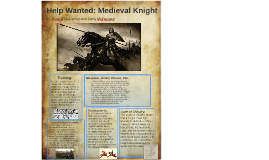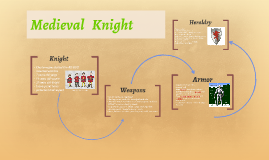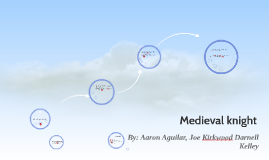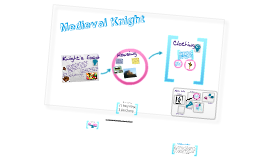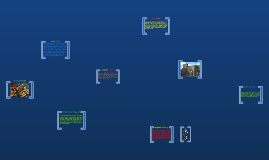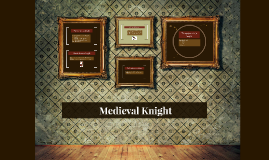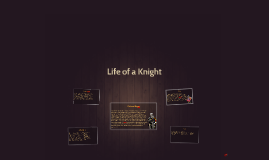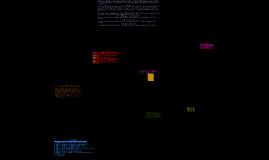Medieval Knight
Transcript: Medieval Knights Daily Life What did they wear? Knights were noblemen so they liked to wear nice clothes away from battle. All knights wore the same things, this consisted of a pair of tights, a tunic (usually linen), then a quilted jerkin and over everything he would wear a surcoat decorated with his coat of arms and a stiff leather belt around his waist. He would also wear either leather shoes or boots. The tunic and tights could be in all different colours because of the different dyes they used. What did they eat? A Knight was a quite wealthy person so they could eat much the same as what the rich did. Like the poor they would eat lots of bread but instead of being made from barley, it was made from wheat, making it taste nicer. They also had a larger variety of meat like deer (venison), boar, seafood, mutton/lamb and chicken. They also liked to eat vegetables such as garlic, onion and beans. If it was fruit it was mainly apples soaked in honey. Wine was used like water; it was drunk all the time. Instead of plates they used trenchers, which were stale pieces of bread cut into squares. Once they were done being used they were given to the poor as food. The richer also had access to spices salt, pepper and cinnamon, these were imported from India. What do they do every day? The daily life of a Knight was quite similar to that of his lord. Most of their day centred on guarding his manor and fighting for his lord. His morning started off at dawn, when the Mass was heard, and then prayers would be made. Then he would have breakfast. After this he may go practise his weapon skills or maintain his fitness. After his mid-morning meal he may accompany his lord hunting or inspecting the manor. Then it was to the manor house for his evening meal and prayers. Then there may be some entertainment such as music, dancing, acrobats or some jugglers, then it was time for bedtime prayers and bed. A Knight's House Knights lived in a manor house not in the castle. A number of farms surrounded a manor house. One manor house supported one knight. It took a number of manors to support a castle. The baron living in the castle might also be a knight. The solders living in the castle were not generally knights. Knights lived in manor houses which were two-storey stone buildings set among a complex of timber outbuildings, often with a bank and ditch or wall and moat surrounding the site. The first floor of the manor house was the house of the knight and his family. The main room was a hall, with a rivate sitting room at one end and bed chambers at the other. Furniture would be simple. There were tables were on trestles that could be taken down and folded away, large oak chests with iron locks contained valuables such as cash, silver, jewellery, books and documents. They used braziers for heating and their lighting would be provided by beeswax candles. Beds were of wooden frames with comfortable mattresses, pillows and coverings. Sometimes they also had curtains. Walls could be covered with hanging embroideries, but carpets would be rare. Ceilings and walls were sometimes painted with reparative patterns or hunting scenes. There was no bathroom so washing would be done in large wooden tubs in the bed chambers. There was no running water, plumbing, water tanks or taps. In the rest of the manor there would be a well, stables, workshops, animal pens, barns and storerooms. This is where the servants slept. Values of a Knight Prowess- Is to have skill, Knights need to have skill in certain areas likes horse riding, wrestling, hunting, reading, writing, sword fighting and battle skills. Honour- Knights need to be able to fight for their kingdom with honour and pride. Liberality- Knights need to be generous and fair. Glory- A Knights needs to be able to not let all his glory go to his head, just because he may have done something great, he needs to stay level headed. Loyalty- Knights need to be loyal to their lord and Kingdom. Courtesy- Knights need to be polite because they are the role models of their kingdom. A Knight's Job The main job of a knight was to fight for his kingdom whenever he was needed. They were always ready, practicing their weapon skills most days and maintaining their fitness. Other than fighting he was also to maintain the land that was given to him by his Lord. This was in exchange for his loyalty, taxes and military services. He was to sever his Lord according to the Code of Chivalry. He was expected to guard his manor and support his Lord in war. In addition to this he may be given a pageboy to teach the skills to becoming a good knight. What knights wore for protection while fighting Knights wore very heavy metal armour. It was made from metal scales which were connected using links in rows across the chest. Then another layer of metal plates was placed on top of the metal scales. Often a surcoat was worn over the top of the armour; this was a loose cotton garment displaying the Knights coat of arms. A Knights






